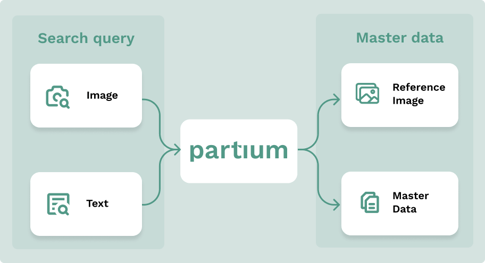Partium's search engine allows users to text search with visual descriptions, part name variations, synonyms, or part functions
Traditional text search engines find parts by comparing the text query directly with the technical descriptions in the master data. These engines are technically simple, show little flexibility to part name variations, and require good knowledge about the part catalog.
Partium's text search is powered by our state-of-the-art, proprietary, and patented machine-learning engine that enables users to search for spare parts semantically. This means that, in addition to using exact technical terms, users can search with visual descriptions or synonyms, making it easier for those who don’t know the exact part details from the master data to perform successful searches.
The semantic power of Partium's Search Engine
Partium's cutting-edge, proprietary, and patented machine-learning engine enables users to search for spare parts using a unique semantic image and text search.
Partium's machine learning engine translates your master data (text descriptions and reference images) and the search queries into concepts. These concepts serve as the foundation for all searches, allowing the engine to establish a connection between the search query and your master data.
As opposed to other search engines, Partium can make the connection between a text query and reference images in your catalog, or between an image query and technical descriptions in the master data. The engine also combines input image and text queries to provide the best possible results and a more precise ranking of potential matches.
 For more information on semantic visual search, please refer to our article on how Partium image part search works.
For more information on semantic visual search, please refer to our article on how Partium image part search works.
How does the Semantic Text Search work?
Instead of just comparing text queries with the technical descriptions in the master data, Partium's search engine is able to find parts that are semantically related to the search query, regardless of whether or not the search term coincides with the part names or any other portion of your master data.
This is particularly useful when the user does not necessarily know the exact part descriptions given in the master data (e.g. new employee, limited language skills, ...) or for incomplete / non-consolidated master data (e.g. due to a company merge, mixed terminology, etc.).
How does the Exact Text Search work?
In addition to the semantic search capabilities, the engine also contains an Exact Text Search capability to filter the results where the exact query words are present in the master data. Examples of such technical terms include IDs, manufacturer brand names, model numbers, or quantities. This is very convenient when the user knows that information with high certainty.
To learn more about how to use semantic text search and exact text search, we recommend reading this article.
